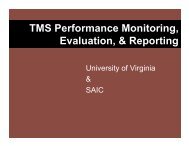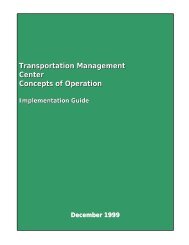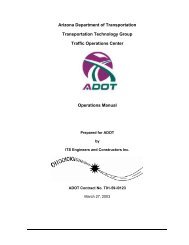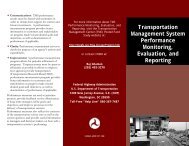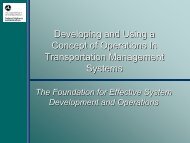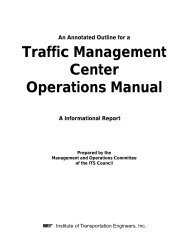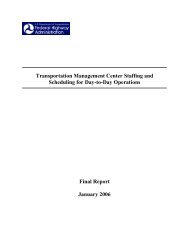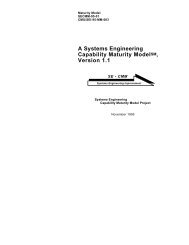Conference Proceedings 26 - Transportation Research Board
Conference Proceedings 26 - Transportation Research Board
Conference Proceedings 26 - Transportation Research Board
- No tags were found...
Create successful ePaper yourself
Turn your PDF publications into a flip-book with our unique Google optimized e-Paper software.
38 PERFORMANCE MEASURES TO IMPROVE TRANSPORTATION SYSTEMS AND AGENCY OPERATIONSI do not mean that performance measures have noplace. They give us a beginning point. They give usa focus. If we are operating several transit routes andwe take those routes together and analyze them in azero-sum game, which go and which stay? Some haveto go if new ones have to come in. Here, performancemeasures such as ridership measures (what we callpassengers per revenue vehicle mile) certainly help.So performance measures do have a place as theyspecifically measure only system performance.You could call this a form of the trade-off analysisthat Steve suggested. But I am taking the concept oftrade-off analysis and trying to apply it to a muchwider selection, not only within the agency but alsowithout the agency: an intermodal, trade-off selection.As you all know, the <strong>Transportation</strong> Equity Actfor the 21st Century (TEA-21) provided a lot of flexiblefunding. Although it was good, it also caused usreal conflict, often with the state DOTs and the roadwaylobbies. We thought, ‘‘Wow, we have a chanceto get some highway money.’’ But it was not thateasy. One of the factors used in this type of trade-offanalysis to make an intermodal decision was calledmode split. From my perspective, that term is bad—you should not use it. Let me tell you why I believethat it is not often a good measure of what we do.Mode split is applied in terms of what the systemcarried and what it can be expected to carry with thistype of investment. What is often missed is the availabilityof or the accessibility to the system. The highwaymode, in most cases, provides 100 percent accessibility.Everybody has access to the roadwaysystem, everywhere. Accessibility to the transit systemdoes not always exist. It exists in some areas butnot as commonly as to roadways. Therefore, applyinga performance measure like that used to makedecisions is often not a very good approach. But therereally are not other measures we can use. When thereare flexible funds to distribute, having good objectiveperformance measures can be very useful. Otherwise,there is a lot of political—not decision making butactual—weighing of objectives, and billions of dollarsare assigned in that way.In the transit industry, thankfully, the FederalTransit Administration has now come up with moremeasurable criteria that are applied as projects areselected to assign what is called ‘‘new-starts money.’’Although this practice is good, it also has created aproblem for transit agencies in trying to collect data.Collecting data for performance measures is a realkey point; it must be collected constantly and analyzedconsistently, so that it is done the same waythroughout the number of years we do it.In summary, several practical issues arise in applyingperformance measures. Maybe studies and researchpapers like what Steve put together will bringus all some focus and common ground on which wecan really apply them. Maybe they could lead us tothink about how to better make judgments based onperformance-based criteria.GENERAL DISCUSSIONIssue: What is the appropriate number of performancemeasures? Is 700 too many?Discussion: Minnesota has some 700 measures, butonly a few are corporate strategic measures. Most ofthe measures are at the operational level.Issue: What are the benefits of creating performancemeasures for nonquantifiable factors? How can thesemeasures be used in the political decision-makingprocess?Discussion: Including nonquantifiable measures isuseful to political decision makers because it givesthem a feel or indication for issues that are importantto the public.Issue: Can we use multimodal performance measuresto make trade-offs between different modal programsand projects?Discussion: We are not there yet in our ability tomake multimodal trade-offs with performance measures.A National Cooperative Highway <strong>Research</strong>Program project is under way that may be of somehelp. At some point, we might recognize that weare comparing apples and oranges and allow thedecision-making process to work with the best informationavailable.Multimodal issues can be addressed through thelong-range planning and investment strategy process,including both quantifiable and nonquantifiable measures.Investment strategies need to be unbalanced inthe early years to achieve a different balance in futureyears. The plan and measures must be updated periodicallyto account for changes in technology andpublic values.Issue: How do you incorporate performance measuresin a multijurisdictional framework?



